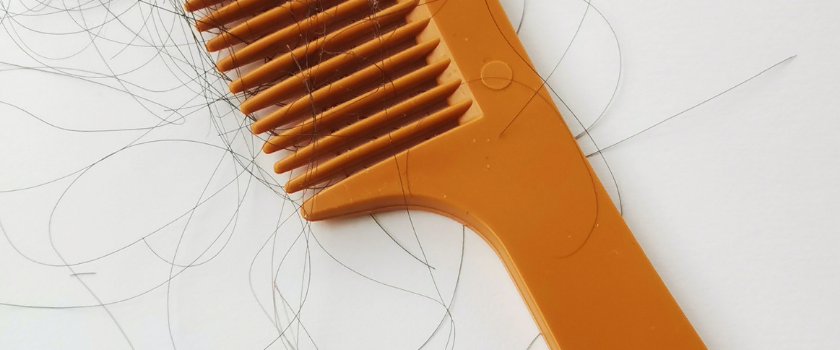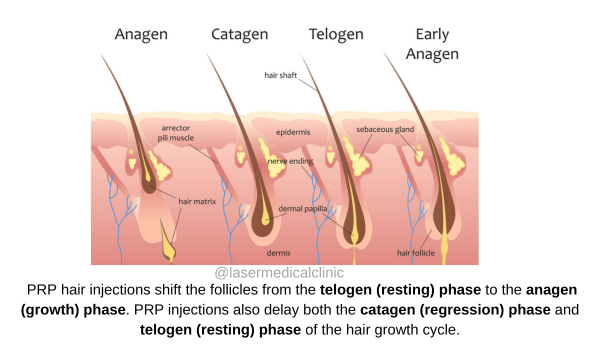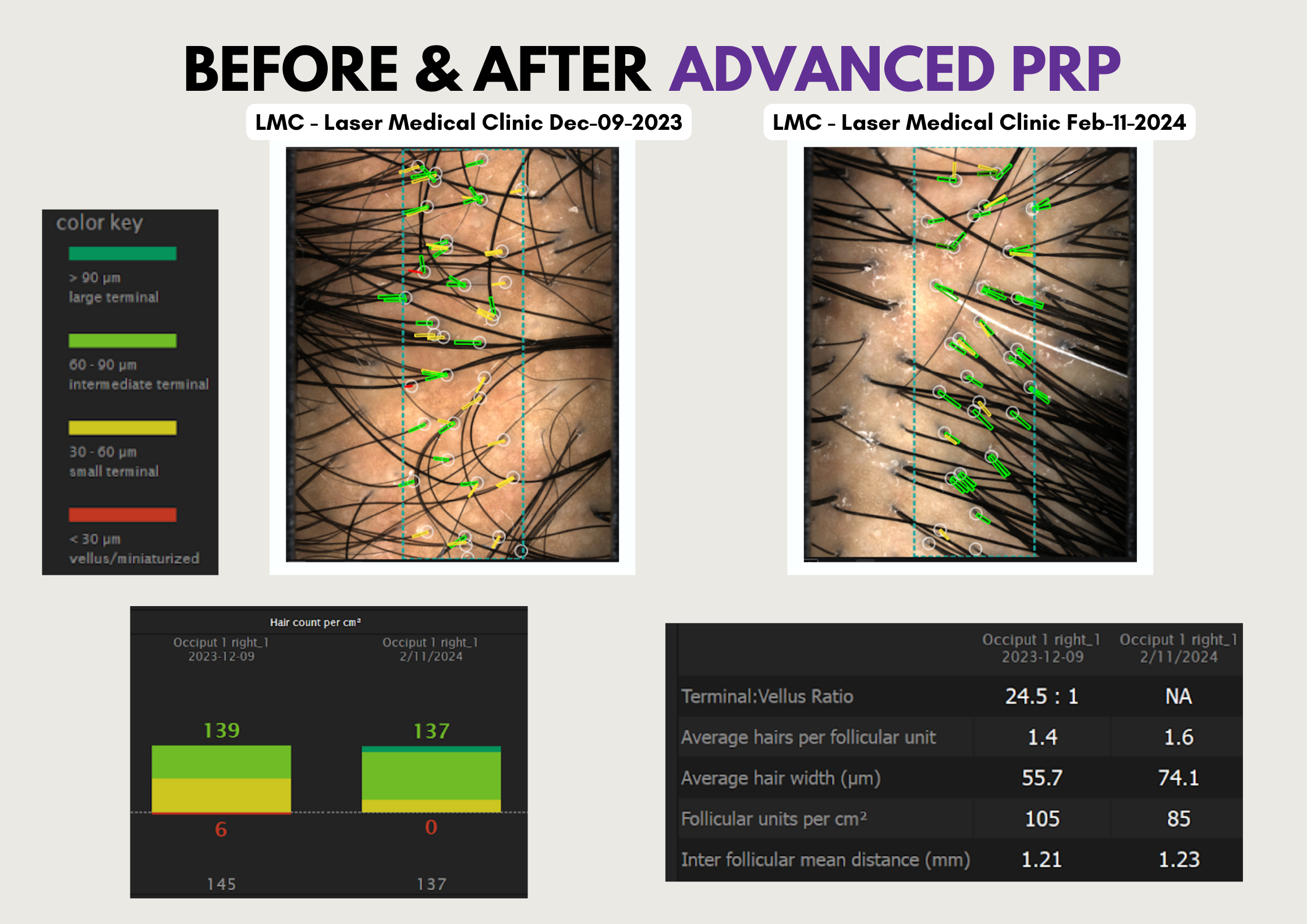
PRP hair shedding is a temporary phenomenon for some and it has some thinking can PRP make hair loss worse? The short answer is no.
The long answer is that platelet-rich plasma (PRP) therapy can effectively treat different types of male and female pattern hair loss. This is an autologous hair restoration procedure that is 100% therapeutic as the procedure uses the patient’s blood. It’s extremely safe, and it has no side effects. PRP injections may cause you to lose more hair for a temporary period, but the key word here is temporary. Hair loss after PRP is rare, but some experience PRP hair shedding as the weaker follicle is shed for healthier new follicles.
When you receive PRP for hair loss, why do some people experience more PRP hair shedding?
- PRP triggering a “shock loss”: Hair shedding is a phenomenon noticed for some individuals after PRP injections. It occurs in a small number of cases after PRP injections to the scalp, about 0.2%. Full recovery occurs in 3-4 months.
- PRP growth factor release: As blood platelets contain growth factors, they stimulate the hair follicles to enter the growth stage of the hair growth cycle, which pushes out old hairs from the existing hair shafts, causing hair shedding. The hair cycle switches to an active anagen phase as more new hair grows, and older hair will fall out. This also shortens the hair cycle, which prompts faster hair regrowth. This is not actual shock loss, but rather an increase in noticeable shedding after the procedure (Arora & Arora, 2020).
In reality, any hair procedure can trigger shock loss.
Shock loss has been documented in hair transplantation (Kerure et al., 2020) and minoxidil hair treatment (Alsantali & Shapiro, 2009). In fact, female hair transplant clients are particularly at risk to experiencing shock loss phenomenon (Rogers, 2014).
The response to PRP hair treatments should ideally be assessed at the end of 6-8 months.
How PRP for Hair Therapy Works

If you’re wondering why some experience shock hair loss or excess hair shedding after PRP therapy, you need to know how it works. PRP therapy is a type of regenerative medicine that has been extensively used for many different medical and aesthetic conditions, including male and female pattern baldness (androgenic alopecia) and alopecia areata.
When using PRP to treat hair loss, the patient’s blood sample is spun in a centrifuge. It is then injected
Growth factors in platelet-rich plasma boost blood flow
During PRP treatment, hair follicles undergo the anagen phase. This process requires the hair bulbs to push out the old hair
The rate at which newly formed hair grows from the roots varies per individual, as each hair follicle undergoes a consistent on-and-off cycle. Individual factors that affect the hair growth cycle include age, genetic predisposition, lifestyle, and current health conditions.
Understanding why hair shedding occurs after PRP requires a clearer understanding of
It is
To better understand why hair shedding occurs after PRP, it’s imperative to understand how the injections affect the hair growth cycle. Hair production has three key phases:
1. The Anagen Phase (the Growth phase)
During this stage, new anagen hairs are continuously developing from the hair follicles. PRP’s role at this stage is to create new blood vessels to improve the supply of nutrients and oxygen to the hair follicles. In addition to stimulating dermal papilla cell division, the rich platelet concentration stimulates hair follicle regeneration (Li et al., 2012).
This growth stage causes old hairs to fall off existing shafts, resulting in shedding as the inactive follicles are awakened and enter the growth stage. With PRP hair therapy, the anagen phase of the hair growth cycle is elongated (Schiavone et al., 2014).
2. The Catagen Phase (the Regression phase)
The regression phase is when the follicles stop multiplying and the blood supply to the scalp decreases, causing the hair follicles to shrink and shed. PRP injections also have an anti-apoptotic effect, so once you’re getting PRP hair therapy, you can prolong the active growth phase of your hair growth cycle. In other words, the catagen phase of the hair growth cycle is delayed (Elghblawi, 2017).
3. The Telogen Phase (the Resting phase)
It is during this phase that the follicles start to rest. During this period, the hair shafts enter a dormant state, so there is no additional hair growth. Prior to PRP injections for hair therapy, the majority of hair follicles will be at this stage of the hair growth cycle. Hair shedding occurs after platelet injections, which shifts the follicles from the telogen to the anagen phase. This causes the miniaturized hair strands to fall off to make room for the longer, thicker ones. Telogen shedding is usually seen in the first 8 weeks of treatment (Lolli et al., 2017)
Conclusion
Hair shedding after PRP hair therapy is not unusual but it’s not permanent. You experience temporary hair loss as the new healthier and thicker hair follicles push the older hair shaft out of the way. Other than growth factors triggering the hair follicles, emotional stress can also prolong alopecia symptoms and make hair shedding worse. In order to prevent this from happening, you should ensure your health is as optimal as possible.
References
Alsantali, A., & Shapiro, J. (2009). Androgens and hair loss. Current Opinion in Endocrinology, Diabetes and Obesity, 16(3), 246–253.
Arora, G., & Arora, S. (2021). Platelet‐rich plasma—Where do we stand today? A critical narrative review and analysis. Dermatologic Therapy, 34(1), e14343.
Elghblawi, E. (2018). Platelet‐rich plasma, the ultimate secret for youthful skin elixir and hair growth triggering. Journal of Cosmetic Dermatology, 17(3), 423–430.
Kerure, A. S., Agrawal, S. M., Dhurat, R., & Ginzburg, A. (2020). Donor area acute effluvium following follicular unit extraction—Trichoscopic simulator of alopecia areata: Series of four cases. Journal of Cutaneous and Aesthetic Surgery, 13(1), 31.
Li, Z. J., Choi, H., Choi, D., Sohn, K., Im, M., Seo, Y., Lee, Y., Lee, J., & Lee, Y. (2012). Autologous platelet‐rich plasma: A potential therapeutic tool for promoting hair growth. Dermatologic Surgery, 38(7pt1), 1040–1046.
Lolli, F., Pallotti, F., Rossi, A., Fortuna, M. C., Caro, G., Lenzi, A., Sansone, A., & Lombardo, F. (2017). Androgenetic alopecia: A review. Endocrine, 57, 9–17.
Rogers, N. E. (2014). Medical therapy for female pattern hair loss (FPHL). 24(3), 81–88.
Schiavone, G., Raskovic, D., Greco, J., & Abeni, D. (2014). Platelet-rich plasma for androgenetic alopecia: A pilot study. Dermatologic Surgery, 40(9), 1010–1019.

New! Clinical Example Demonstrating how PRP hair shedding is a temporary process leading to stronger and more dense hair. Key parameters noted on the report and their possible implications in terms of hair shedding and hair improvement after PRP:
- Hair Count per cm²: On 2023-12-09, there were 139 hairs counted, and on 2024-02-11, there were 137. This slight decrease could suggest minimal hair shedding in this area of the head
- Average Hairs per Follicular Unit: Initially 1.4, which has slightly increased to 1.6. This indicates an improvement in hair density, suggesting that PRP might have been effective in promoting hair growth or the development of new hairs in each follicular unit.
- Average Hair Width (µm): There is an increase from 55.7 micrometers to 74.1 micrometers, suggesting that the individual hairs have become thicker, which is typically a sign of improved hair health, possibly due to PRP.
- Follicular Units per cm²: The count has decreased from 105 to 85. This could indicate a reduction in the number of hair groupings per area, which might suggest some shedding of hair or changes in hair grouping. However, if the individual hairs are thicker and healthier, this might not be a negative sign.
- Inter Follicular Mean Distance (mm): The distance has slightly increased from 1.21mm to 1.23mm. This is a very slight change and could reflect the reduced number of follicular units per cm².
The color key on the left side indicates different hair thickness categories, with colors assigned to:
- large terminal (thick) hairs
- intermediate terminal hairs
- small terminal hairs
- vellus/miniaturized hairs.
The data suggest that there may have been an increase in hair thickness after treatment, which is a positive sign of hair improvement.
In summary, while there is a slight decrease in the overall hair count, the average thickness and density of hair in the follicular units have improved, which are positive indicators typically associated with successful PRP treatments. The results would suggest an improvement in hair quality, though there’s a slight reduction in quantity.
To book your complimentary consultation appointment, call us at 416-548-6548 Book a Consultation
